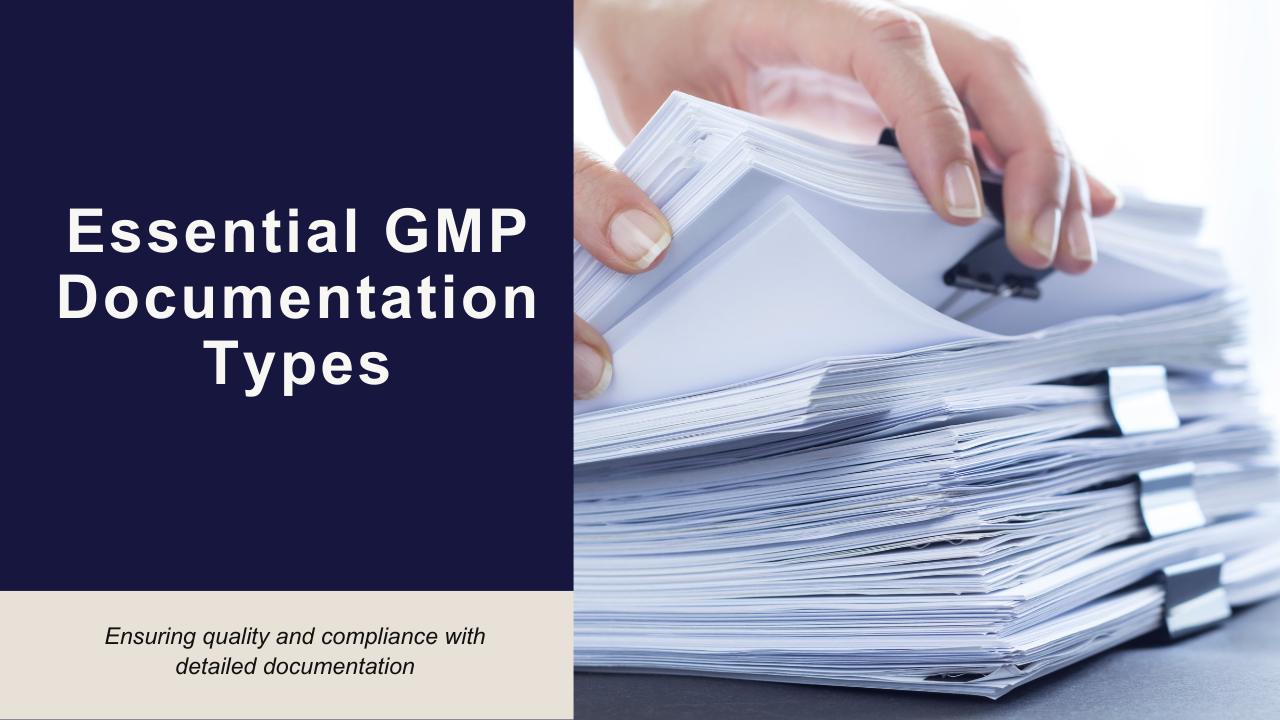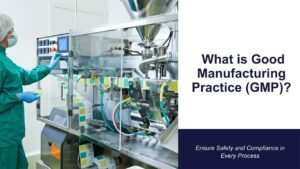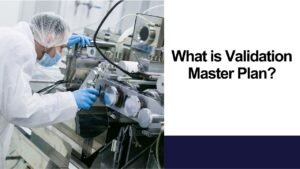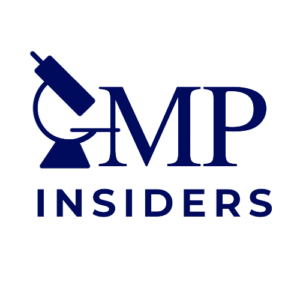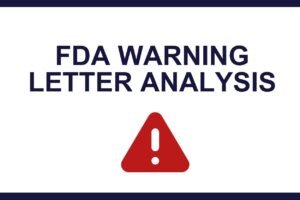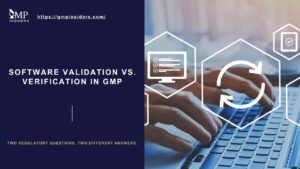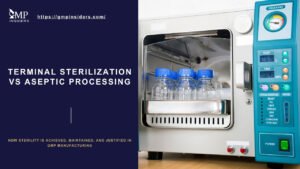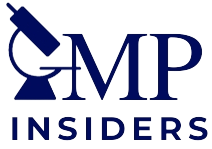In pharmaceutical manufacturing, proper GMP documentation is crucial for maintaining quality, safety, and regulation compliance. It provides a detailed record of every step in the production and testing process, ensuring traceability, consistency, and the ability to investigate any potential issues.
This article explores the various types of GMP documentation, such as Standard Operating Procedures (SOPs), batch records, and validation protocols, highlighting their importance in upholding high standards in the industry.
Types of GMP Documents
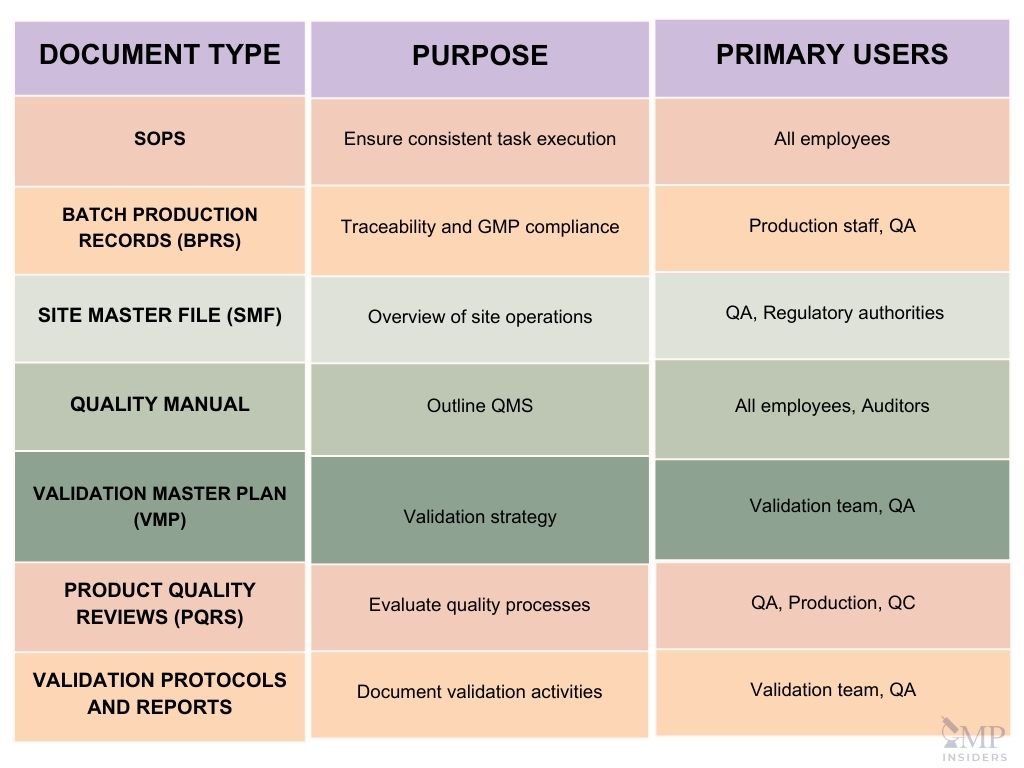
GMP documentation encompasses various essential documents to ensure quality and compliance in pharmaceutical manufacturing. Key documents include Standard Operating Procedures (SOPs) for consistent task execution, batch production records for process traceability and validation protocols to confirm system standards.
Other essential documents are the Site Master File (SMF), Quality Manual, and various records that support regulatory adherence and operational efficiency. Each document type plays a vital role in maintaining consistency, traceability, and compliance in the industry.
Standard Operating Procedures (SOPs)
Standard Operating Procedures (SOPs) are comprehensive, written instructions designed to ensure consistent execution of specific functions within an organization. They are vital for maintaining uniformity, quality, and compliance across various processes.
SOPs serve several crucial functions:
- Consistent еxecution of processes: SOPs provide a standardized approach to performing tasks, ensuring that each step is executed consistently, regardless of who performs it. This uniformity is crucial for maintaining product quality and regulatory compliance.
- Reducing the risk of errors and deviations: By providing clear, step-by-step instructions, SOPs minimize the likelihood of mistakes and deviations from established procedures. This helps in maintaining process integrity and product safety.
- Training tool for new employees: SOPs are valuable training resources for new hires, offering detailed guidance on performing specific tasks correctly and safely. They help in onboarding and ensuring that all employees follow the same procedures.
Key Components and Examples of SOPs
The main components of SOPs include:
- Title: Clearly states the purpose.
- Scope: Defines applicability and limitations.
- Definitions: Clarifies specific terms.
- Responsibilities: Details responsibilities.
- Procedure: Step-by-step instructions.
- References: Related documents or regulations.
- Revision History: Tracks changes.
Examples:
- Cleaning and sanitization: Steps for cleaning equipment and facilities.
- Equipment calibration: Instructions for calibrating and maintaining equipment.
- Batch record review: Procedures for reviewing and approving batch records.
Best Practices for Writing and Maintaining SOPs
- Use clear, concise language: Avoid jargon and ensure instructions are easy to follow.
- Involve relevant stakeholders: Engage employees performing the tasks.
- Regularly review and update: Reflect current practices and regulations.
- Training and compliance: Provide training to ensure understanding and adherence.
- Accessibility: Ensure SOPs are easily accessible to all employees, both in print and electronically.
Tip: Use visual aids like flowcharts and diagrams in SOPs to enhance clarity and understanding.
SEE ALSO: Guide on How to Write SOPs in Pharma Industry
Records
Maintaining accurate and comprehensive records ensures product quality, regulatory compliance, and operational efficiency. Different types of records serve distinct purposes in the manufacturing process. The primary types of records in GMP include:
- Batch production records
- Equipment logs
- Training records
- Quality control records
Importance of Accurate and Real-Time Record-Keeping
Maintaining accurate and real-time records is essential for several reasons:
- Compliance:
- Accurate records demonstrate adherence to GMP regulations and standards.
- They provide documented evidence of compliance during regulatory inspections and audits.
- Traceability and Data Integrity:
- Records provide a complete history of the production process, from raw materials to finished products.
- They facilitate the traceability of products, enabling quick identification and recall if necessary.
- Investigation:
- Detailed records are crucial for investigating deviations, non-conformances, and other issues.
- They help identify root causes and implement corrective and preventive actions.
- Audit Readiness:
- Comprehensive and well-maintained records ensure readiness for internal and external audits.
- They enable auditors to verify that all processes and procedures are properly documented and followed.
Tip: Implement electronic record-keeping systems to enhance accuracy and facilitate real-time updates.
Site Master File (SMF)
A Site Master File (SMF) is a detailed document providing an overview of a pharmaceutical manufacturing site’s operations, quality management, production, and quality control processes. It helps regulatory authorities understand the site’s structure, policies, and practices, facilitating GMP inspections and compliance assessments.
Purpose of an SMF
- Overview: Describes the manufacturing site, including structure and operations.
- Inspection Facilitation: Aids regulatory authorities in preparing for GMP inspections.
- Compliance Demonstration: Showcases adherence to GMP requirements.
- Transparency: Enhances understanding of quality management and operational processes.
Key Components
- General Information: Site location, contact details, key personnel, and organizational structure.
- Quality Management: Quality policy, QMS description, and documentation practices.
- Personnel: Roles, responsibilities, and training programs.
- Premises and Equipment: Layout, major equipment, and maintenance procedures.
- Production: Product types, processes, and in-process controls.
- Quality Control: QC lab details, testing procedures, and stability testing.
- Documentation: List of SOPs, protocols, and batch record management.
- Complaints and Recalls: Procedures for handling complaints and recalls.
- Self-Inspection: Internal audit programs and CAPA plans.
- Contract Manufacture and Analysis: Details of outsourced activities and quality agreements.
Best Practices for Preparing an SMF
- Accuracy and Completeness: Include all relevant information and regularly review updates.
- Clear Language: Use straightforward language and avoid jargon.
- Logical Organization: Use structured formats with clear headings.
- Visual Aids: Incorporate diagrams and flowcharts to illustrate processes.
- Cross-functional input: Collaborate with different departments for comprehensive information.
Tip: Train staff on the SMF content to ensure everyone understands its role in compliance.
Quality Manual
A Quality Manual is a top-level document that outlines an organization’s quality management system (QMS). It defines quality policies, objectives, organizational structure, and responsibilities, ensuring all employees adhere to the company’s quality standards and demonstrating compliance with regulatory authorities.
Purpose of a Quality Manual
- Define Quality Policies: Articulates the commitment to quality.
- Establish Quality Objectives: Sets measurable goals for quality.
- Describe Organizational Structure: Outlines roles and responsibilities.
- Provide a Framework for Procedures: Offers an overview of QMS procedures.
- Ensure Regulatory Compliance: Demonstrates adherence to standards and GMP requirements.
Tip: Regularly update the Quality Manual to reflect changes in regulations and internal processes.
Key Components
- Introduction: Purpose, scope, and company overview.
- Quality Policies: Commitment to quality and governing policies.
- Quality Objectives: Measurable goals and monitoring methods.
- Organizational Structure: Roles, responsibilities, and organizational chart.
- QMS Overview: Description of key processes and procedures.
- Document Control: Procedures for managing and accessing documents.
- Training and Competency: Training programs and competency assessments.
- Audits and Reviews: Internal audit procedures and management reviews.
- Continuous Improvement: Strategies for quality improvement.
- Compliance and Certification: Regulatory requirements and certifications.
Management Review
Management reviews evaluate the effectiveness of the Quality Management System (QMS) and ensure continuous improvement. These reviews help senior management:
- Assess QMS performance.
- Identify improvement areas.
- Allocate resources effectively.
Key Elements and Frequency of Management Reviews
Key elements:
- Quality objectives: Review performance against goals.
- Audit results: Summary of audit findings.
- Process performance: Evaluation of processes.
- CAPA: Status and effectiveness of corrective actions.
- Customer feedback: Analysis of complaints and feedback.
- Regulatory changes: Review of new requirements.
Frequency: At least annually, more often if necessary.
Examples of Issues Addressed in Management Reviews
- Deviations and non-conformances: Root causes and corrective actions.
- Resource needs: Staffing, training, and infrastructure requirements.
- Process improvements: Opportunities for optimization.
Tip: Document action items and follow-up from management reviews to ensure issues are addressed and improvements are implemented.
Validation Master Plan (VMP)
A Validation Master Plan (VMP) is a comprehensive document outlining a company’s strategy for validating its systems, processes, and equipment. The VMP ensures compliance with GMP requirements, providing a roadmap for all validation activities to maintain product quality and regulatory compliance.
Purpose of a VMP
- Define Scope and Objectives: Establishes boundaries and goals of the validation program.
- Provide Structured Approach: Ensures consistent execution and documentation of validation activities.
- Ensure Compliance: Demonstrates adherence to GMP standards.
- Facilitate Communication: Aligns various departments on validation responsibilities.
- Support Audit Readiness: Serves as an accessible document for auditors.
Key Components
- Introduction: Overview, company background, and regulatory requirements.
- Scope: Defines covered and excluded processes and systems.
- Validation Policy: Objectives and guiding principles.
- Organizational Structure: Roles, responsibilities, and reporting structure.
- Validation Strategy: Risk assessment, validation life cycle, and documentation.
- Validation Activities: Details on process, equipment, computer systems, and cleaning validation.
- Validation Protocols and Reports: Templates and content for protocols and reports.
- Change Control: Procedures for managing changes and impact assessments.
- Training: Requirements and programs for personnel training.
- Review and Approval: Processes and authorities for document approval.
- Glossary and References: Definitions and relevant documents.
Tip: Implement electronic documentation and change control systems to streamline processes and improve traceability.
Product Quality Reviews (PQRs)
Product Quality Reviews (PQRs) are comprehensive evaluations of production and quality control processes for a specific product. They ensure ongoing GMP compliance and identify improvement opportunities.
Components of an Effective PQR
Components include:
- Starting materials: Review of raw and packaging materials.
- In-process controls: Analysis of critical parameters.
- Finished product results: Review of testing compliance.
- Batch records: Examination for trends or issues.
- Deviations: Summary of deviations and CAPA activities.
- Stability data: Analysis of stability studies.
- Customer complaints: Trends and responses.
- Regulatory compliance: Assessment of compliance with requirements.
Best Practices for Conducting PQRs
- Systematic data collection: Ensure comprehensive data from all sources.
- Cross-functional involvement: Engage quality, production, and regulatory representatives.
- Documentation and follow-up: Document findings and implement corrective actions.
Tip: Use PQRs as a tool for continuous improvement by regularly reviewing findings and implementing identified improvements.
SEE MORE: What is a Product Quality Review – PQR?
Batch Manufacturing Records
Batch manufacturing records (BMRs) provide a detailed history of the manufacturing process, ensuring traceability and GMP compliance. They verify process control and product quality and facilitate audits.
Information Included in Batch Manufacturing Records
The Batch Manufacturing Records include:
- Batch identification: Unique identifier for each batch.
- Production dates: Dates and times of significant steps.
- Personnel: Identification of individuals performing and supervising each step.
- Materials: Details of raw materials, quantities, and lot numbers.
- Equipment: Identification of equipment used.
- In-process controls: Results of in-process tests.
- Deviations: Documentation of deviations and investigations.
- Finished product testing: Results of final product tests.
Steps for Maintaining Accurate Batch Records
- Real-time documentation: Record information immediately.
- Regular audits: Ensure completeness and accuracy.
- Training: Educate personnel on proper documentation.
- Review process: Thorough review before batch release.
Tip: Implement checklists to ensure all necessary information is recorded in batch production records.
SEE MORE: The Role of Batch Manufacturing Records (BMR) in GMP
Master Batch Records (MBRs)
Master Batch Records (MBRs) are comprehensive templates providing detailed production instructions for each batch, ensuring consistency and GMP compliance.
Key Components and Examples of MBRs
Components:
- Product information: Name, dosage form, strength.
- List of materials: Raw materials, quantities, specifications.
- Manufacturing instructions: Detailed production steps.
- In-process controls: Monitoring and control criteria.
- Packaging and labeling: Instructions for packaging and storage.
- Testing specifications: Requirements for testing.
- Deviation handling: Procedures for deviations.
Examples:
- Tablet manufacturing MBR: Instructions for producing tablets, including granulation, drying, compression, and coating.
- Sterile product MBR: Procedures for aseptic processing.
Best Practices for Creating and Maintaining MBRs
- Collaborative development: Engage quality, production, and R&D.
- Regular review and updates: Reflect process improvements and regulatory changes.
- Detailed and clear instructions: Prevent misinterpretation.
- Control issuance and revisions: Ensure traceability and compliance.
Tip: Use electronic MBR systems to enhance efficiency and control over document revisions.
Quality Control Documentation
Quality control (QC) documentation ensures products meet quality criteria. It includes records of testing and verification activities. Data integrity is a critical aspect of QC documentation, guaranteeing that all data is accurate, complete, and consistent throughout its lifecycle. Maintaining data integrity is vital for regulatory compliance, as it ensures that all records are reliable and can be trusted by regulatory bodies and consumers alike.
Types of Quality Control Documents
QC documentation includes:
- Test methods: Procedures for QC tests.
- Raw material testing records: Results of raw material tests.
- In-process testing records: Documentation of in-process tests.
- Finished product testing records: Results of final product tests.
- Stability study records: Stability study data.
- Environmental monitoring records: Results of environmental monitoring.
- Specifications: Detailed descriptions of the requirements the product or material must meet.
- Certificates of Analysis (CoA): Documents that provide the results of specific tests conducted on a batch of product or material, certifying its compliance with specifications.
- Instrument Logbooks: Record the usage, calibration, and maintenance of laboratory instruments.
- Laboratory Notebooks/Electronic Laboratory Notebooks: Document the preparation and use of reagents, solutions, standards, and samples.
Importance of Accuracy and Compliance in Quality Control Documentation
Accurate and compliant QC documentation ensures:
- Product quality: Verifying compliance with specifications.
- Data Integrity and Traceability: Clear record of testing activities.
- Regulatory compliance: Demonstrating adherence during audits.
- Issue identification: Promptly identifying and investigating quality issues.
Tip: Implement double-check systems for critical QC documentation to minimize errors and ensure accuracy.
Validation Protocols and Reports
Validation protocols outline how validation activities will be conducted, specifying methods, acceptance criteria, and documentation requirements.
Types of validation:
- Process validation: Ensures processes produce products meeting specifications.
- Equipment validation: Confirms equipment performance.
- Cleaning validation: Demonstrates cleaning procedures’ effectiveness.
Steps Involved in Writing and Approving Validation Reports
- Define scope and objectives: Outline validation study scope and objectives.
- Develop protocol: Create a detailed validation protocol.
- Conduct validation: Perform validation activities and record results.
- Analyze data: Determine if acceptance criteria are met.
- Document findings: Prepare a validation report summarizing results.
- Review and approval: Submit for review and approval.
Tip: Include risk assessments in validation protocols to identify potential issues and mitigation strategies.
Product Release Documentation
Product release documentation provides evidence that a product batch has been manufactured and tested according to GMP and specifications, ensuring quality-assured products.
Components of a Product Release Document
Includes:
- Batch production records: Complete history of manufacturing.
- Quality control test results: All test results for the batch.
- Certificate of analysis: Certification of quality criteria compliance.
- Deviation and investigation report: GMP Documentation of deviations.
Process for Ensuring Compliance and Quality in Product Release
- Comprehensive review: Thoroughly review all relevant GMP documentation.
- Verification: Ensure all testing and quality checks are complete.
- Deviation management: Verify investigation and resolution of deviations.
- Approval: Approve release when all criteria are met.
Tip: Use a checklist for product release documentation to ensure all necessary information is included and reviewed.
Quality Agreements
Quality Agreements define roles, responsibilities, and expectations in the pharmaceutical industry, ensuring compliance, protecting intellectual property, and managing risks.
Key Elements of a Quality Agreement
Key elements:
- Scope of work: Detailed description of services and deliverables.
- Quality requirements: Specifications and standards.
- Roles and responsibilities: Clarification of duties.
- Confidentiality: Provisions for information protection.
- Payment terms: Conditions and schedule for payments.
- Dispute resolution: Procedures for handling disputes.
- Termination clauses: Conditions for contract termination.
Best Practices for Managing and Maintaining Quality Agreements
- Clear documentation: Ensure terms and conditions are clearly documented.
- Regular reviews: Periodically review contracts for relevance.
- Open communication: Maintain transparent communication.
- Compliance tracking: Implement systems for tracking compliance.
Tip: Use contract management software to streamline contract creation, review, and compliance tracking.
Best Practices for GMP Documentation
Best practices for GMP documentation are critical for maintaining compliance and ensuring product quality in pharmaceutical manufacturing. This includes using standardized templates to ensure consistency, implementing robust version control to track document changes, and conducting regular reviews to keep documents up-to-date with current regulations and practices.
Additionally, training personnel on proper documentation procedures and maintaining secure, accessible storage for all records are essential for effective GMP documentation management.
Tip: Conduct periodic refresher training sessions to keep personnel updated on GMP documentation practices and regulatory changes.
SEE MORE: Good Documentation Practice: Ensuring Data Integrity and Compliance in the Pharmaceutical Industry
FAQ: GMP Documentation
How Do Standard Operating Procedures (SOPs) Differ From Work Instructions (WIs) in GMP Documentation?
Standard Operating Procedures (SOPs) provide broad, comprehensive guidelines for performing various tasks to ensure consistency and compliance across departments within a GMP-regulated facility.
In contrast, Work Instructions (WIs) offer detailed, step-by-step instructions for specific tasks within an SOP, often used directly by operators. SOPs cover wider processes and ensure overall regulatory compliance, whereas WIs focus on the precise execution of individual tasks.
How Should Laboratory Notebooks Be Maintained and Reviewed for GMP Compliance?
Laboratory notebooks should be maintained using bound, pre-numbered books with entries made in ink to ensure permanence. Each entry should be signed and dated, with errors corrected by a single line through the mistake, initialed, and dated.
Regular reviews by a supervisor or qualified individual are essential to ensure completeness and accuracy, with the reviewer’s signature and date included on each reviewed page or task.
How Should GMP Documentation for Contract Manufacturing Organizations (CMOs) Be Managed?
GMP documentation for Contract Manufacturing Organizations (CMOs) should be managed through clear agreements that outline responsibilities and a robust document control system to ensure consistency. Regular audits, proper training, and an effective change control process are crucial to ensure ongoing compliance and effective documentation management.
What Types of GMP Documents Are Required for Documenting Cleaning Procedures for Production Equipment?
Documenting cleaning procedures for production equipment requires detailed Cleaning SOPs outlining the processes and methods. Cleaning logs are necessary to record each cleaning event, including the date, time, personnel, and equipment cleaned. Additionally, cleaning validation protocols and reports document the validation processes and results, while checklists ensure all steps are completed.
Conclusion
GMP documentation ensures compliance with regulatory requirements, maintains product quality, and facilitates traceability and accountability. It provides a documented history of production, ensuring processes are well-defined and controlled.
By adhering to best practices for GMP documentation, organizations can consistently produce safe, effective, and high-quality products. Continuous improvement, regular training, and stringent documentation controls are key to maintaining compliance and achieving manufacturing excellence.

